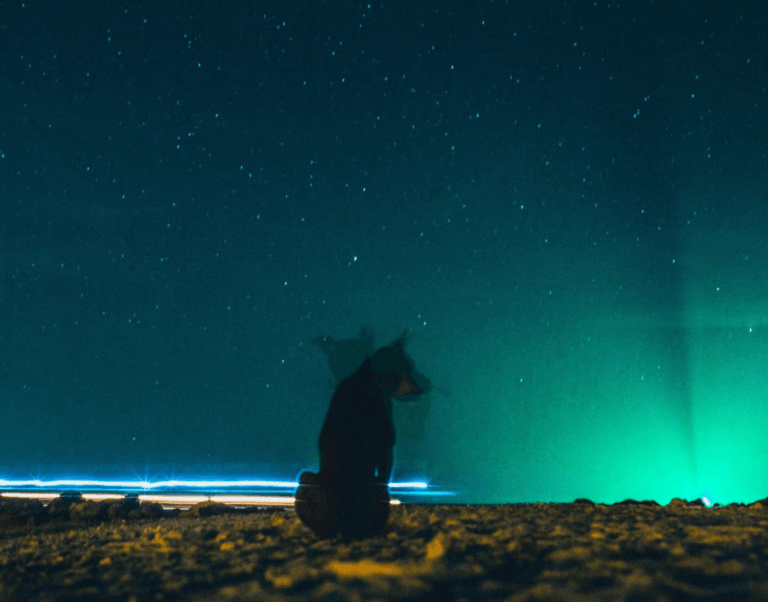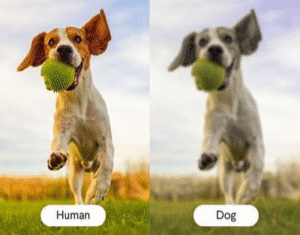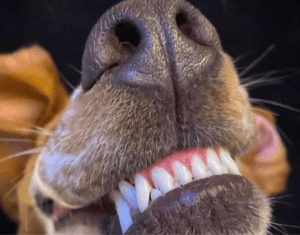If you’ve ever wondered whether your dog sees you creeping to the fridge for a midnight snack, the answer is a resounding yes. While humans rely heavily on artificial light at night, dogs have built-in night vision that allows them to move, navigate, and even detect movement in near darkness. But how well can they really see when the sun goes down?
目录
Let’s uncover the truth about dog night vision, how their eyesight compares to ours, and some fascinating facts that will make you appreciate your pup’s superpower even more.
Can Dogs See in the Dark?
Photo by Jovan Vasiljević
Yes! Dogs can absolutely see in the dark, and in many ways, their low-light vision surpasses ours. While they don’t have the same night vision capabilities as cats, their eyes are designed to function efficiently in dim lighting.
The reason? A combination of eye structure, evolutionary adaptation, and heightened senses allows them to pick up details that humans simply can’t.
How Does a Dog’s Night Vision Work?
Dogs have several biological advantages that enhance their ability to see in dim conditions.
1. Dogs Have More Rod Cells Than Humans
Rod cells are the photoreceptor cells in the retina responsible for low-light vision. Dogs have significantly more rod cells than humans, which means they can detect movement, shapes, and objects in dim lighting far better than we can. The more rods you have, the better you can see in dim lighting.
2. They Have a Tapetum Lucidum (a Built-in Mirror)
One of the most important components of dog night vision is the tapetum lucidum—a reflective layer behind the retina that bounces light back through the eye.
- This is why a dog’s eyes appear to glow in the dark when light hits them.
- It allows them to make better use of whatever light is available, making their night vision much sharper.
3. Their Pupils Dilate More Than Ours
Dogs have much larger pupils than humans, allowing them to let in more light in low-light conditions. This helps them see even when it’s just moonlight or faint street lights illuminating their surroundings.
4. They Can Detect Motion at Night Up to 20 Times Better Than Humans
Even in pitch-black darkness, dogs can sense movement far better than we can. This is why they sometimes bark at “nothing”—chances are, they’ve detected something you can’t see.
5. Dogs Are Crepuscular, Not Nocturnal
Contrary to popular belief, dogs aren’t nocturnal. Instead, they are crepuscular, meaning they’re most active during dawn and dusk—times when their night vision gives them an advantage.
6. A Wider Field of Vision
While dogs may not have crystal-clear HD vision, they make up for it with a wider field of view. Depending on the breed, their eyes are set more to the side of their head, allowing them to see more of their surroundings.
This makes them great at spotting movement in low light, even if the details aren’t as sharp.
How Does a Dog’s Night Vision Compare to a Human’s?
Let’s get real—if you and your dog were placed in a dark room and asked to navigate your way out, your dog would win every single time.
Comparison Chart: Dog vs. Human Night Vision
| Feature | 狗类 | Humans |
| Tapetum Lucidum | Yes, helps reflect light | No, relies only on direct light |
| Rod Cells (Light Sensitivity) | 高 | 低 |
| Cones (Color Vision) | Limited color perception | Wide range of colors |
| Field of Vision | Wider (up to 250 degrees) | Narrower (about 180 degrees) |
| Detail Perception | 中度 | High (in good lighting) |
While humans may have the upper hand in seeing finer details and vibrant colors during the day, dogs dominate when the lights go out.
Surprising Facts About Dog Night Vision
Now that you know dogs can see in the dark, here are some fascinating facts that make their low-light eyesight even more impressive.
1. Dogs See a Different Color Spectrum at Night
Many assume dogs see only in black and white, but that’s not entirely true. While their daytime color vision is limited to blue and yellow, those same colors remain visible to them even in low light.
Human night vision = black & white.
Dog night vision = muted blues and yellows.
So, while you see a shadowy backyard at night, your dog sees a soft, color-tinted version of it.
2. Their Eyes Adjust to Darkness Faster Than Ours
Ever fumbled around in the dark waiting for your eyes to adjust? Dogs don’t struggle as much. Their rod-rich retina and tapetum lucidum allow them to adapt to low light almost instantly, making them far more comfortable in the dark than we are.
3. Senior Dogs Can Lose Their Night Vision
Just like in humans, a dog’s eyesight can decline with age. Senior dogs may develop cataracts or progressive retinal atrophy (PRA), making it harder for them to navigate in the dark. If your aging pup hesitates in dim lighting, consider adding soft nightlights in key areas to help them feel more secure.
4. Dogs Can See in Moonlight Almost as Clearly as Daylight
Thanks to their larger pupils, high rod cell count, and tapetum lucidum, dogs can see well with just a sliver of light—whether it’s the moon, streetlights, or even reflections from surfaces.
5. Their Night Vision is an Evolutionary Superpower
Dogs inherited their low-light vision from their wolf ancestors, who hunted primarily at dawn and dusk. While your domesticated pup no longer needs to stalk prey for survival, their enhanced night vision remains a useful tool.
How to Support Your Dog’s Vision
While dogs have impressive night vision, they still need proper care to maintain healthy eyesight. Here are a few ways you can help:
1. Provide a Balanced Diet for Eye Health
Nutrients like Vitamin A, lutein, and beta-carotene are essential for your dog’s eye health. Some great vision-boosting foods 包括
- Carrots (yes, they help dogs too!)
- Blueberries
- Leafy greens
- Eggs.
2. Schedule Regular Vet Checkups
例行工作 eye exams can catch early signs of cataracts, PRA, or other eye issues. If you notice your dog bumping into things at night, squinting, or having trouble finding toys, it might be time for a vet visit.
3. Keep Their Eyes Clean
Some breeds—especially those with bulging eyes (like Pugs or Shih Tzus)—are more prone to eye infections. Cleaning their eyes with Vet-Approved Eye Wipes can help prevent irritation and infection.
4. Use Nightlights for Senior Dogs
If you have an older dog, installing soft nightlights near stairs and doorways can make nighttime navigation easier for them.
5. Play Vision-Boosting Games
Toys that encourage tracking and movement detection, like glow-in-the-dark fetch balls, can help keep their eyesight sharp.
常见问题
Can Puppies See in the Dark?
Puppies are born blind and slowly develop their eyesight over the first few weeks. However, once their vision matures, they inherit the same dog night vision abilities as adult dogs.
If you’ve got a puppy and they seem a little hesitant in dim conditions, don’t worry—it just takes time for them to get used to their surroundings.
Do Dogs Need Light to See at Night?
While dogs don’t need as much light as we do, they do require some light to see. They can’t navigate in absolute pitch-black conditions, but they only need minimal light to detect movement and shapes.
Think about how you might see things in a room lit by just a small night light—that’s similar to how dogs’ ability to see at night works.
Do Some Dog Breeds Have Better Night Vision?
Yes! Some breeds have better low-light vision than others.
- Hunting breeds (like Beagles and Bloodhounds) rely on their keen sense of smell more than sight but still benefit from enhanced low-light vision.
- Herding dogs (like Border Collies and Australian Shepherds) often have better dog vision in low light since their ancestors needed to work into the evening.
- Guard dogs (like German Shepherds and Dobermans) have been bred for surveillance and protection, making strong night vision a major advantage.
Smaller, more housebound breeds, like Pugs or Bulldogs, may not rely on night vision as much since their ancestors weren’t as active in the dark.
Why Do My Dog’s Eyes Glow in the Dark?
We’ve all seen it—those eerie glowing eyes staring at you from across the room at night. But why do dogs’ eyes glow in the dark?
That glow is caused by the tapetum lucidum, which amplifies low-light vision. The color of the glow depends on the dog’s breed, age, and the specific structure of their tapetum. Some dogs’ eyes glow green, while others may have a blue or yellow hue.
主要收获
- Dogs can see in the dark better than humans, thanks to the tapetum lucidum and increased rod cells.
- They don’t have perfect night vision, but they require much less light than we do.
- Hunting, herding, and guard dogs typically have better dog vision in low light.
- If your dog’s eyes glow in the dark, that’s the tapetum lucidum doing its job.
- While dogs navigate low-light environments well, they still need some light to see.
Final Thoughts: Your Dog Sees More Than You Think
Whether it’s tracking motion in the dark, detecting shapes in low light, or instantly adapting to dim conditions, your dog’s night vision is a fascinating superpower.
So next time they bark at “nothing” in the middle of the night, remember—they probably see something you don’t.
And honestly, that’s kind of cool.
You can also read: 猫能在黑暗中视物吗:猫科动物的夜视能力





